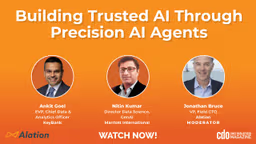AI News Bureau
Adobe CDO Reveals How Its Refreshed AI-First Strategy Is Impacting Business
Written by: CDO Magazine Bureau
Updated 12:00 PM UTC, Thu August 7, 2025
Adobe is synonymous with creativity and innovation, powering digital experiences for millions of users worldwide through its suite of flagship products such as Photoshop, Illustrator, Premiere Pro, and Acrobat. With an expansive global presence, Adobe serves individuals, enterprises, and institutions, enabling creativity, streamlining workflows, and transforming digital business landscapes. In recent years, Adobe has been at the forefront of integrating artificial intelligence (AI) deeply into its products, fundamentally reshaping user experiences and internal operations alike.
In the first part of this three-part interview series, Bin Mu, Chief Data Officer and VP of Enterprise Data & Analytics at Adobe, sits down with Rohit Choudhary, CEO of Acceldata, to discuss the evolution of Adobe’s data and AI strategies. Mu sheds light on how a refreshed, AI-centric strategy is significantly altering both internal workflows and external stakeholder interactions. He shares compelling insights into Adobe’s innovative approaches, emphasizing AI-driven operational efficiency, accuracy, and strategic agility.
Edited Excerpts
Q: Previously, you mentioned refreshing your entire data and AI strategy. Could you elaborate on that?
We refreshed our charter and strategy for several reasons. The previous charter primarily revolved around data strategy, roadmap, a unified data platform, data analytics, governance, and delivery via AI-enabled products — it was essentially data-centered. The reason for the refresh is AI, which fundamentally changes everything. Now our strategy is AI-first and AI-centric. It includes an AI-driven data strategy and an integrated roadmap tailored specifically for an AI-first approach.
Additionally, our strategy now emphasizes AI-driven actionable intelligence, agentic AI, and Agent OS. We’ve also introduced upskilling for AI fluency to our charter. This change reflects our need as a team, an organization, and a company to prepare for the AI era. Another driving factor for adopting an AI-first approach is the advancement of agentic AI and Agent OS, which allow many functions to be automated, significantly reducing human intervention.
The implications are profound, and I’m still fully grasping their true impact. However, immediate benefits include simplified workflows, shortened cycle times, and reduced conflicts, as AI consistently optimizes for business outcomes.
Q: How is AI impacting your internal and external stakeholders, and who are you prioritizing?
The impact is comprehensive. It’s 360 degrees, affecting both internal stakeholders and external partners.
Take, for instance, calculating Annual Recurring Revenue (ARR), a complex process involving hundreds of business rules. Traditionally, whenever policies or commerce models changed, updating these calculations was lengthy and error-prone. To address this, we’ve broken down these business rules into foundational Lego-block-like taxonomies. These building blocks allow for versatile configurations, enabling rapid restructuring as rules evolve.
Initially, we approached rule management through drag-and-drop configurations to minimize coding. But with the advent of AI agents, our thinking evolved further. Now, specific AI agents represent distinct Lego-block taxonomies, significantly enhancing adaptability and efficiency.
This approach boosts productivity dramatically. Eventually, we plan to provide this flexible interface directly to our business partners, empowering them to independently adjust rules, which then automatically propagate through the agent network. Ultimately, this AI-driven model frees us from foundational tasks, elevating our work to strategic levels.
Q: You mentioned structured financial metrics like ARR. Structured data demands extreme accuracy, unlike unstructured data, which often provides broader context. How are you balancing intelligence and accuracy?
This balance is central to our current efforts and is shared by many industry peers. Our focus is ensuring that the semantic layer of data is pristine — essentially a ‘gold’ source of truth.
Consider a practical scenario: historically, if the CFO requested the ARR for Adobe Firefly for April in Germany, it could trigger a complex, days-long process with potentially inaccurate results, primarily due to rigid BI dashboards structured along multiple dimensions.
Today, using the modern stack and the medallion framework, the semantic or ‘gold’ layer contains all relevant business rules and metrics comprehensively. It consolidates attributes related to an entity into a single record, significantly improving speed, accuracy, and governance.
Achieving this semantic layer involves systematically breaking down business rules into structured taxonomies, or ‘Lego blocks,’ transitioning smoothly from raw data to a coherent semantic model. AI excels in this structured approach. For example, using Cursor AI, I efficiently created a semantic financial table in two hours, a task traditionally taking a data engineer two months.
CDO Magazine appreciates Bin Mu for sharing his insights with our global community.





